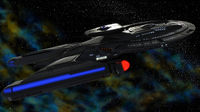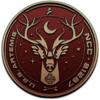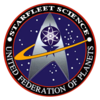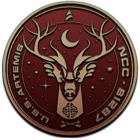USS Artemis-A/Science
| USS Artemis-A | ||
|---|---|---|
 ACTIVE STATUS | ||
| ||

|
Science Department | 
|
| USS Artemis NCC-81287 |
The USS Artemis Science Department consists of officers and enlisted crew whose duty is to conduct scientific research and provide research-based information to the staff. Being a Luna class Explorer/Reconnaissance Science Vessel, the Artemis is equipped with advanced scientific instruments, including the sensor pod characteristic to the class. The extensive science facilities allow the crew to study various different subjects.
Facilities
Science Centre
The Science Centre is the focal point of all scientific research on the Artemis. Taking almost the entirety of Deck 9, the Centre hosts majority of the science offices and laboratories, including the largest and the most important ones.
In the Chief Science Officer's office, the CSO can direct the work of the Department, have meetings with the ship's scientists and other people, and conduct their own studies in privacy. The office is equipped with computer terminals for the CSO’s personal use as well as to observe the status of the science facilities and projects.
Near the CSO's office is the Science office space, which has desks and computer terminals for department's other personnels' use. The scientists can come here to write their reports and papers and easily reach out to their colleagues and supervisors. The ACSO and administrative assistant have their dedicated desks, other workstations can be reserved for long-term use or occupied by first taker for short-term use.
Science Laboratories 1-4 are general laboratories that can easily be modified to serve different purposes, from archaeology to xenology. They are mid-sized, highly modular rooms for short to mid-length projects that don't require significant amount of specialized equipment.
The Astrometrics lab is dedicated to the study of stars and other objects, such as stellar systems, nebulae and planets, although it can seamlessly work similar to the Stellar Cartography as well. The lab has several workstations and large, curved wall display, but it is also equipped with holoemitters and localised gravity controls for less confined observations.
The Stellar Cartography lab is large, cylinder shaped room that spans a few decks in height. The workstations located in the middle, all walls of the lab operate as a large display. In this lab, the scientists study the sensor recordings and compare them to the existing maps. These efforts allows them to discover new stars, objects and anomalies, as well as to update the maps for navigation, reporting them frequently to the Starfleet Command.
The Astrophysics Lab is dedicated for the study of physics and chemistry of celestial objects, spatial and subspatial phenomena, and anomalies the ship may encounter or observe. The lab contains several specialized equipment for "hands-on" research experiments, as well as several workstations and a smaller variant of Astrometrics display for observational and theoretical study.
The Geology Lab serves the physical and chemical study of composition of planets and other rocky objects and is frequented not only by geologists but also by planetary scientists, hydrologists, chemists and others. The lab has several chemistry stations with appropriate safety equipment and access to sample storages, and workstations and holoemitters for observations and other work.
The Hydroponics Bay is, along with the Arboretum, the hotspot for botanical research. The bay contains several containers divided by transparent aluminium, each with highly modifiable microclimate and rows of vertical gardens, for the purpose of growing plants for research. The produce of the bay may also be used for food, decorative and other purposes.[1]
This notice was placed here by Jovenan, so go bug her to finish the page if nothing's happening.
Other Science Facilities
Hazardous Materials Lab Science Laboratories 5-7 Science Laboratories 8-11
Related Facilities & Resources
Bridge Sensor Arrays Arboretum Library Medical Laboratories Engineering Labs and testing facilities
References
- ↑ Hoo, LtCmdr Yogan Yalu, USS Artemis-A, 240005.27

